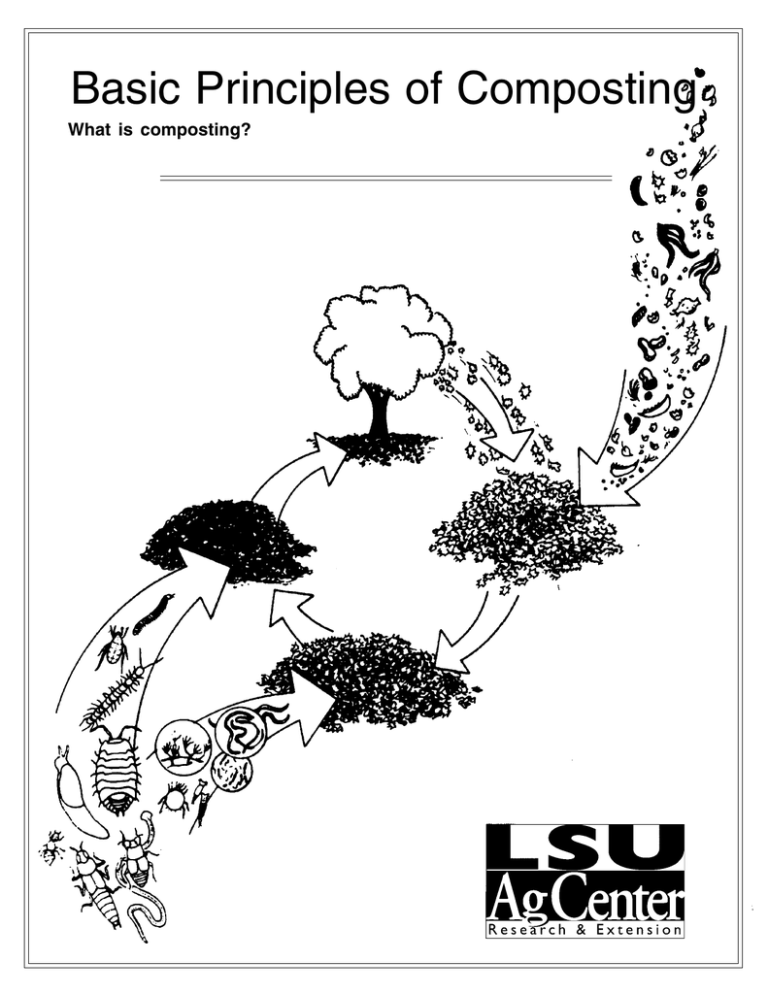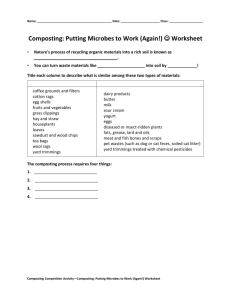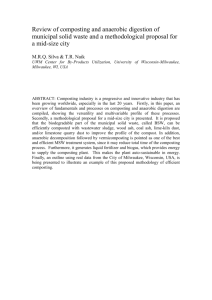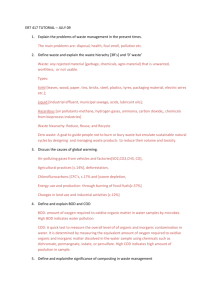Basic Principles of Composting
advertisement

Basic Principles of Composting What is composting? Basic Principles Composting of Composting is the controlled biological decomposition and conversion of solid organic material into a humuslike substance called compost. Composting is the process of letting nature transform organic materials into a material with environmentally beneficial applications. The process is aerobic, meaning it requires oxygen. The process uses various microorganisms such as bacteria, actinomyces and fungi to break down the organic compounds into simpler substances. In natural surroundings, leaves and branches that fall to the ground form a rich, moist layer of mulch that protects the roots of plants and provides a home for nature’s most fundamental recyclers: worms, insects and a host of microorganisms too small to see with the naked eye. Composting is a viable process of treating solid waste for beneficial use and destroying pathogens, diseases and undesirable weed seed. By properly managing air, moisture and nutrients, the composting process can transform large quantities of organic material into compost in a relatively short time. During composting, the microorganisms consume oxygen while feeding on organic matter. Active composting generates a considerable amount of heat, and large quantities of carbon dioxide and water vapor are released into the air. The carbon dioxide and water losses can amount to half the weight of the initial organic materials, so composting reduces both the volume and mass of the raw materials while transforming them into a beneficial humuslike material. Composting is most efficient when the major parameters -- oxygen, nitrogen, carbon, moisture and temperature -- which affect the composting process are properly managed. Oxygen and Aeration An aerobic composting process consumes large amounts of oxygen. During the first days of composting, easily degradable components of the organic materials are rapidly metabolized. The need for oxygen and the production of heat are greatest during the early stages and then decrease as the process continues. If the supply of oxygen is limited, the composting process slows and the process becomes anaerobic (without oxygen). A minimum oxygen concentration of 5% within the pore spaces of the composting material is recommended for a wellmanaged compost facility (air contains about 21% oxygen). Temperature In addition to providing oxygen, aeration removes heat, water vapor and other gases trapped within the composting materials. In fact, the required rate of aeration for heat removal can be 10 times greater than for supplying oxygen. Temperature frequently determines how much and how often aeration is required. As a matter of convenience, science has subdivided and given names to the temperature ranges in which certain microorganisms are most active. Composting is most efficient when the temperature of the composting material is within the two ranges known as Mesophilic (80o-120o F) and Thermophilic (105o-150o F). Mesophilic temperatures allow effective composting, but most experts suggest maintaining temperatures between 110o and 150o F. The 3 Thermophilic, or higher, composting temperatures are desirable because they destroy more pathogens, diseases, weed seeds and insect larvae in the composting materials. The regulations have set the critical temperature for killing human pathogens at 55o C (131o F) for a specified time. This time and temperature should destroy most plant pathogens as well. The critical temperature for destroying most weed seed is 145o F. Microbial decomposition during composting releases large amounts of energy as heat. The insulating qualities of the composting materials lead to an accumulation of heat, which raises the temperature. The materials lose heat as water evaporates and as air movement carries away the water vapor and other gases. Turning and aeration of a compost pile accelerate the heat loss and can be used to reduce the temperature. Heat accumulation in a compost pile can rise above 160o F (71o C) because of heat generated by microbial activity and the insulating qualities of the composting materials. When the temperature reaches this level, many of the microbes die or become dormant. The composting process effectively stops and does not recover until the population of the microorganisms recovers. The temperatures should be monitored and, when the composting material becomes too hot, heat loss should be accelerated by forced aeration or by turning. from place to place. In theory, biological activity is optimum when the materials are saturated. Activity ceases entirely below a 15% moisture content. Efficient activity is achieved when the moisture is maintained between 40% and 60%. At moisture levels above 60%, water displaces much of the air in the pore spaces of the composting materials. This limits air movement and leads to anaerobic conditions. The desired starting moisture content of organic materials composted should be higher than 40%. The moisture content generally decreases as the organic material decomposes. For co-composting, mix materials that are too wet with materials that are too dry to achieve a 50%-60% moisture content of the blended materials. With dry materials, such as leaves, add water directly to the compost pile. Since most of the heat loss from composting occurs by the evaporation of water, the materials should not be allowed to dry below 40% moisture. Low moisture increases the chance of high temperature damage and spontaneous combustion. Generally, more moisture will evaporate than is added to the composting windrow by rain. Moisture levels should be maintained so the materials are thoroughly wet but not waterlogged or dripping excessive water. There are instruments and procedures for accurately determining moisture content, but as a rule, the materials are too wet if water can be squeezed out of a handful and too dry if the handful does not feel moist to the touch. The optimum time to add water is during the aeration or turning operation. Moisture Odors Moisture is the lifeblood of the metabolic processes of the microbes. Water provides the medium for chemical reactions, transport nutri4 ents and allows the microorganisms to move Odors are the single biggest threat to a composting operation. Nothing is more persistent than an angry neighbor capable of causing a composting operation to close because of odors. Theoretically, aerobic composting does not generate odorous compounds as the anaerobic process does. Objectionable odors can come from certain raw materials or the process itself if composting is not properly managed. There are three primary sources of odors at a composting facility: 1) odorous raw materials, 2) ammonia lost from high nitrogen materials and 3) anaerobic conditions within the windrows or composting facility. Anaerobic conditions can be minimized by proper management. Use a good mix of raw materials, avoid overly wet mixes, manage lechate and rainfall runoff, monitor temperatures and turn to aerate the materials regularly. Bad odors can be controlled by providing extra carbon in the mix and maintaining the pH below 8.5. A high pH encourages the conversion of nitrogen compounds to ammonia, which further adds to alkalinity. The most common causes of odors at a composting site are strong-smelling raw materials. Odors come to the site with the materials but, with proper management, should dissipate when the materials begin composting. Nutrients Carbon (C), nitrogen (N), phosphorus (P) and potassium (K) are the primary nutrients required by the microorganisms involved in composting. Nitrogen, phosphorus and potassium are also the primary nutrients for plants, so nutrient concentrations also influence the value of the compost. Many organic materials contain enough quantities of nutrients for composting. Excessive or insufficient carbon or nitrogen will affect the process. Carbon provides microorganisms with both energy and growth; nitrogen is essential for protein and reproduction. In general, biological organisms need about 25 times more carbon than nitrogen. Therefore it’s important to provide carbon and nitrogen in appropriate proportions. The ratio of carbon to nitrogen is referred to as the C:N ratio. See table 1 for organic materials and corresponding C:N ratios. Raw materials blended to provided a C:N ratio of 25:1 to 30:1 are ideal for active composting, although initial ratios of 20:1 up to 40:1 consistently give good results. For some applications, C:N ratios of 50:1 and higher are acceptable. With C:N ratios below 20:1 the available carbon is fully used without stabilizing all of the nitrogen. The excess nitrogen may be lost to the atmosphere as ammonia or nitrous oxide, and odor can become a problem. Mixes with C:N ratios higher than 40:1 require longer composting times for the microorganisms to use the excess carbon because of the absence of available nitrogen. The C:N ratio is a useful guide to formulate composting recipes, but the rate at which the carbon compounds decompose must also be considered. For example, straw decomposes and releases carbon to the microorganisms more easily than woody materials. This occurs because the carbon compounds in woody materials are bound by lignins which are organic compounds highly resistant to biological breakdown. Similarly, carbon in the simple sugars of fruit wastes is more quickly consumed by the microorganisms than the cellulose carbon in straw. 5 Decomposition by the microorganisms occurs on the surface of the organic particle. Therefore degradability can be improved by reducing the particle size, which increases the surface area, as long as porosity doesn’t become a problem by decreasing the airspace and needed oxygen. Other Considerations pH: The composting process is relatively insensitive to pH within the range commonly found in mixtures of organic materials, largely because of the broad spectrum of microorganisms involved. The preferred pH is in the range of 6.5-8.0. pH does become a consideration with raw materials containing a high percentage of nitrogen. A high pH, above 8.5, encourages the conversion of nitrogen compounds to ammonia. Formulas for calculating a composting recipe are presented. To use the equations, you must know the carbon and nitrogen characteristics of the materials. Table 1 lists characteristics of some organic materials including carbon and nitrogen contents. If the carbon and nitrogen contents of a material are not known, it’s not unusual to select a material similar in characteristics with known C:N values and calculate C:N ratios for the desired recipe of materials. Time: The time required to transform raw materials into compost depends on many factors. Proper moisture content, C:N ratio and frequent aeration ensure the shortest composting period. A well-managed composting operation should produce quality compost within four months. The ratio of mixed materials is adjusted until a desired moisture content between 40% and 60% is achieved. Using the selected materials based on moisture content, the C:N ratio of the mixture can be calculated. Co-composting % Moisture Content = Co-composting refers to composting that includes more than one organic material. Some co-composting operations determine the portions of each material by trial and error to obtain a compostable mixture. The trial and error method could cause problems later. To obtain the best ingredients for composting within the optimum time period without excessive odors, follow a mixing procedure based on the physical and chemical characteristics of the composting materials. An example is presented of a procedure used to estimate the amount of each material to include in a mixture to obtain a desired C:N ratio or moisture content for a cocomposting operation. When the material characteristics are unknown, the look and feel method may be the only alternative. 6 Developing a recipe for composting can sometimes be a balancing act to get the C:N ratio as well as the moisture content within acceptable ranges. Moisture content can be critical. Excessive moisture will lead to anaerobic conditions, odors and will slow decomposition. The effect of C:N ratios less than ideal is less critical. It’s best to develop the initial recipe based on moisture content and adjust the portions of materials to obtain an acceptable C:N ratio. Wet Weight - DryWeight x100 Wet Weight Moisture Content (wt.) = % Moisture 100 Dry Weight = Total weight - Weight of Water Proportions of dry materials can be calculated on the basis of the carbon and nitrogen contents since it’s relatively easy to add moisture to the composting mix. Calculations for C:N ratios are done on a dry weight basis, so it’s important to know how the laboratory results are determined, on a wet or dry basis. Nitrogen Content = Dry Weight X (%N/100) Carbon Content = Dry Weight X (%C/100) Carbon Content Nitrogen Content Carbon Nitrogen Ratio (C/N) = Equations for mixing materials: (1) Mix Moisture = Wt. of Water in material A + water in B + water in C+... Total Weight of all Material Weight of water to be added, Mx = W(Md - Mi) (1 - Md) Symbols: Mx = Amount of water to be added, tons Md = Desired moisture content, % total weight/100 Mi = Initial material moisture content/100 W = Initial feedstock weight, tons including water (2) C:N Ratio = Wt. of “C” in Material A + “C” in B + “C” in Material C Wt. of “N” in Material A + “N” in B + “N” in C Required amount of material “A” per pound of material “B” based on the desired moisture content. Weight of material A = Moisture of material B - Desired moisture Desired moisture - Moisture of material A Now check the C:N ratio using equation (2). Required amount of material “A” per pound of material “B” based on the desired C:N Ratio. Weight of Material A = % Nb % Na X (R - Rb) (1 - Mb) X (1 -Ma) (Ra - R) Symbols: A = pounds of material A per pound of material B Ma = Moisture content of material A Mb = Moisture content of material B % Na = % Nitrogen in material A % Nb = % Nitrogen in material B R = Desired C:N ratio Ra = C:N ratio of material A Rb = C:N ratio of material B Now check the moisture content using equation (1) 7 Recipe Sample Calculations Given: Chicken Manure Sawdust Moisture = 70% Nitrogen = 6% C:N ratio = 10:1 Moisture = 35% Nitrogen = .11% C:N ratio = 500:1 Blend to the desired moisture content. 1 pound of manure (M) contains Water Dry Matter Nitrogen Carbon = = = = .7 lb .3 lb (.3 x .06) = .018 lb (.018 x 10) = .18 lb 1 pound of sawdust (S) contains Water Dry Matter Nitrogen Carbon = = = = .35 lb .65 lb (.65) x .0011) = .00072 lb (.00072 x 500) = .36 lb Moisture Content = Wt. of water in manure + Wt. of water in sawdust Total Weight MC = 0.7 + ( .35 x S ) 1+S (.60)(1 + S) = 0.7 + 0.35S 0.60 + 0.60S = 0.7 + 0.35S .25S = 0.1 S = 0.4 lb of sawdust per lb of manure 8 Assume the moisture content = 60% Table 1 - Characteristics of Organic Material Material N% (dry weight) C:N ratio (weight to weight) Moisture Bulk density content % (pounds per (wet weight) cubic yard) 1.2 2.8 2.3 0.4-0.8 0.6-0.8 7.7 1.5 2.8 1.2 13 7 22 20 56-123 60-73a 7 19 31 42 60 59 8 9-18 12 12 50 71 1,197 1,411 798 32 185 1,021 1,298 0.9 0.9-2.6 1.5 0-0.4 7.2-7.6 .67 1.2 61 18 20-49 28 25 113-1120 4-6 85 - 61 78 62-88 75 7-12 40-50 60-70 1,540 1,570 185-219 324 1,200 4.5 2.7 2.5-4 11a 19 11-13 62 87 - 1,585 - 13-14 3-3.5 10-78 - 4.6-8.2 2.0 6.8 6.5-14.2 4.0-5.4 28 5.2 2.6-5.0 35-61 10 94 50-81 - Crop residues and fruit/vegetable-process wastes Apple filter cake Apple-processing sludge Cocoa shells Coffee grounds Corn cobs Corn stalks Cottonseed meal Cotton gin trash Cranberry filter cake (with rice hulls) Cranberry plant (stems, leaves) Cull potatoes Fruit wastes Potato-processing sludge Potato tops Rice hulls Soybean meal Sugarcane bagasse Sugarcane filter press mud Tomato-processing waste Vegetable produce Vegetable wastes Fish and meat processing Blood wastes (slaughterhouse waste and dried blood) Crab and lobster wastes Fish-breading crumbs Fish-processing sludge Fish wastes (gurry, racks and so on) 9 Material Mixed slaughterhouse waste Mussel wastes Poultry carcasses Shrimp wastes N% (dry weight) C:N ratio (weight to weight) Moisture Bulk density content % (pounds per (wet weight) cubic yard) 7-10 2-4 - - 3.6 2.4b 9.5 2.2 5 3.4 63 65 78 - 1.6-3.9 1.5-4.2 2.7 3.7 1.4-2.3 0.8-1.7 4-10 1.3-3.9 1.9-4.3 2.6 12-15a 11-30 18 13 22-50 29-56 3-10 13-20 9-19 16 22-46 67-87 79 83 59-79 52-67 62-75 60-75 65-91 26 756-1,026 1,323-1,674 1.215-1.620 1,377-1,620 783 1.9-2.9 0.2-0.25 14-16 127-178 69 18-20 - 2.0-6.9 5.6 1.9 5-16 6 16 72-84 - 1,075-1,750 - 1.2-1.4 0.7-3.6 1.8-3.6 0.3-1.1 0.6-1.1 0.3-0.5 38-43 15-32 15-19 48-150 48-98 100-150 65-68 8-10 4-27 - 58-378 - Manures Broiler litter Cattle Dairy tie stall Dairy free stall Horse-general Horse-race track Laying hens Sheep Swine Turkey litter Municipal wastes Garbage (food waste) Paper from domestic refuse Sewage sludge Activated sludge Digested sludge Straw, hay, silage Corn silage Hay-general Hay-legume Straw-general Straw-oat Straw-wheat 1 0 Material N% (dry weight) C:N ratio (weight to weight) Moisture Bulk density content % (pounds per (wet weight) cubic yard) Wood and paper Bark-hardwoods Bark-softwoods Corrugated cardboard Lumbermill waste Newsprint Paper fiber sludge Paper mill sludge Paper pulp Sawdust Telephone books Wood-hardwoods (chips, shavings, etc.) Wood-softwoods (chips, shavings, etc.) 0.10-0.41 0.04-0.39 0.10 0.13 0.06-0.14 0.56 0.59 0.06-0.8 0.7 116-436 113-1,285 563 170 398-852 250 54 90 200-750 772 8 3-8 66 81 82 19-65 6 259 195-242 1140 1403 350-450 250 0.04-0.23 212-1,131 - - 9-25 40-80 5-27 53 16 20-30 15 70 93 300-400 500-800 100-300 400-500 429 1,296 405 Yard wastes and other vegetation Grass clippings Loose Compacted Leaves Loose and dry Compacted and moist Seaweed Shrub trimmings Tree trimmings Water hyacinth-fresh 2.0-6.0 0.5-1.3 1.2-3.0 1.0 3.1 - Selected References 1. 2. 3. 4. Compost Engineering Principles and Practices, Haug, Roger Tim, Ann Arbor Science Publishers,First Edition 1994. Compost Facility Operating Guide, The Composting Council, Alexandria, Virginia, 1994. On Farm Composting Handbook, NRAES-54, Cooperative Extension Service, Ithaca, New York, 1992. Solid Waste Composting, O’Leary, Philip, Patrick Walsh and Aga Razvl, 1989-90. Table 1: Approximate C:N ratios of some organic materials. 1 1 Billy J. Cochran, Associate Specialist (Environmental Education) William A. Carney, Extension Associate (Environmental Education) Louisiana State University Agricultural Center, H. Rouse Caffey, Chancellor Louisiana Cooperative Extension Service, Jack L. Bagent, Vice Chancellor and Director Pub. 2622 (1M) 4/96 Issued in furtherance of Cooperative Extension work, Acts of Congress of May 8, and June 30, 1914, in cooperation with the United States Department of Agriculture. The Louisiana Cooperative Extension Service provides equal opportunities in programs and employment.







